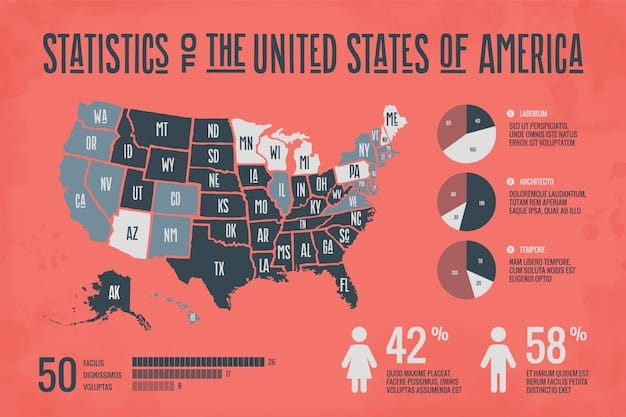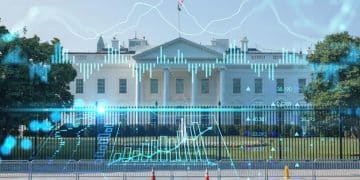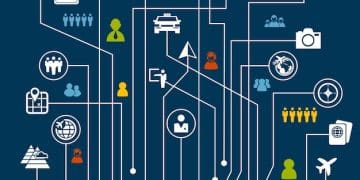Unveiling the 2025 US Census: Demographic Shifts and Future Implications

Unveiling the 2025 US Census Data: What New Demographic Trends Reveal About the Nation’s Future will offers a crucial lens into America’s evolving identity, highlighting shifts in age, race, and urbanization, each trend bearing profound implications for policy and societal adaptation.
The Unveiling the 2025 US Census Data: What New Demographic Trends Reveal About the Nation’s Future offers a critical overview of the transformations occurring across the American demographic landscape, paving the way for policymakers and communities to adapt to a reshaped nation.
Understanding the 2025 Census Landscape
The 2025 US Census represents a pivotal moment for understanding the nation’s evolving composition. It goes beyond a simple headcount, offering profound insights into population distribution, age demographics, racial and ethnic diversity, and economic dynamics.
Historical Context and Evolution of the Census
The US Census has been conducted every ten years since 1790. Its original purpose was to apportion seats in the House of Representatives. Over time, its scope has expanded to encompass a wide range of demographic and socioeconomic variables, essential for informed decision-making at all levels of government and in the private sector.
Key Changes and Methodological Updates for 2025
Significant methodological adjustments may be incorporated in the 2025 Census to enhance accuracy and inclusivity. These potential updates could involve refined sampling techniques, improved outreach to underserved communities, and advanced statistical modeling to account for emerging demographic trends. The goal is to provide a more precise and representative snapshot of the US population.
- Enhanced digital data collection methods to improve response rates.
- Targeted outreach programs to ensure inclusivity of hard-to-reach populations.
- Real-time data analysis tools for immediate insights and adjustments.
In essence, the 2025 Census is poised to offer a comprehensive and nuanced portrait of the American populace, equipping leaders and communities with the knowledge necessary to address future challenges and capitalize on emerging opportunities.

Age Demographics: The Graying of America and Youthful Hubs
One of the critical trends is the ‘graying of America,’ marked by an increasing median age and a substantial rise in the older adult population. Simultaneously, there are regions where youthfulness thrives, driving economic innovation and social change. The Census data should reveal these dynamics.
The Rise in Median Age
The national median age has been steadily increasing, reflecting longer life expectancies and, in some regions, declining birth rates. This shift has notable implications for healthcare systems, retirement planning, and social security programs. Understanding the granular aspects of this trend is essential for policymakers to prepare for future demographic challenges. Regions with very high median ages may face workforce shortages and increased demand for geriatric care, while others potentially struggle from lack of infrastructure.
Youthful Population Centers and Their Drivers
Conversely, certain states and urban centers are experiencing a surge in their youth populations. This is often fueled by growing tech industries, educational opportunities, and a lower cost of living compared to traditional urban hubs. These areas are poised to become innovation hubs, attracting investment and driving economic growth. A high youth population can put a strain on the schools, or increase demand for affordable housing.
- The growth of retirement communities in states like Florida and Arizona, impacting local economies.
- Migration of young professionals to tech hubs in cities like Austin and Seattle.
- Regional disparities in healthcare access and quality for elderly populations.
The interplay between an aging population and the rise of youthful population centers presents both challenges and opportunities for the nation. Strategic planning and resource allocation based on data is imperative for sustainable development.
Racial and Ethnic Diversity: A Mosaic Unfolding
The United States has always been a melting pot, but the 2025 Census will further illuminate the extent of its racial and ethnic diversity. Understanding these shifts is essential for promoting inclusivity and equity.
Growth of Minority Populations
The growth of racial and ethnic minority populations continues to outpace that of the White population. This trend is reshaping the country’s cultural, social, and political landscape. The rise in diversity prompts discussions about representation, social justice, and equal opportunities.
Emerging Multi-Racial Identities
An increasing number of individuals identify as multi-racial, reflecting evolving societal norms and attitudes. This burgeoning multi-racial demographic presents unique challenges and opportunities for identity formation, community building, and social integration. They require data collection methodologies to evolve, and there needs to be a more nuanced strategy for understanding the multi-racial composition of the United States.

America’s racial and ethnic diversity is set to deepen further, underscoring the need for inclusive policies, culturally competent services, and a commitment to social equity.
Urbanization and Rural Shifts: The Great American Shuffle
The movement of people between urban and rural areas is never static. The 2025 data will provide nuanced insights into the push and pull factors causing migration.
Urban Growth and Its Challenges
Many cities will continue to experience population growth, primarily driven by economic opportunities and cultural amenities. However, this growth brings challenges such as housing shortages, traffic congestion, and strains on infrastructure. Policymakers need to address these issues to maintain the livability and sustainability of urban centers.
Resurgence of Rural Areas
Interestingly, some rural areas are experiencing a resurgence, fueled by remote work opportunities and a desire for a lower cost of living. This reversal of the traditional urban migration pattern presents unique opportunities for rural development, including investments in broadband infrastructure and healthcare services. It is important to note that rural resurgence is often linked to an aging population. The influx and outflux need to be managed.
- Affordable housing initiatives in high-growth urban areas.
- Investments in public transit to alleviate congestion.
- Broadband expansion projects in rural communities.
The dynamics between urbanization and rural shifts are reshaping the American landscape, requiring innovative solutions to ensure balanced and sustainable development.
Economic Implications: Workforce and Income Disparities
Changes in demographics inevitably affect the economy. The census data will likely reveal shifts in the workforce, income disparities, and the overall economic landscape.
Changing Workforce Dynamics
An aging population and evolving skill sets are creating shifts in the workforce. A decline in the labor force participation rate among older workers is causing labor shortages in certain industries. Meanwhile, investments in education and retraining programs can help bridge skill gaps and prepare the workforce for future job demands.
Income Inequality Trends
Income inequality continues to be a pressing issue in the United States. The census data reveals disparities across different demographic groups. Policies aimed at increasing access to education, healthcare, and affordable housing can help reduce income inequality and promote economic mobility.
Economic Implications: Workforce and Income Disparities highlight the need for strategic investments in education, job training, and social safety nets to ensure economic opportunity for all.
Policy Implications: Healthcare, Education, and Infrastructure
Demographic changes require policy adjustments in various sectors. Planning for the future of healthcare, education, and infrastructure requires census-driven insights.
Healthcare Access and Delivery
As the population ages, healthcare systems need to adapt to meet the increasing demand for geriatric care. Ensuring access to affordable and quality healthcare services for all demographic groups is essential for promoting public health and well-being. It is expected that there will be an increased need for home healthcare, telemedicine initiatives, and preventative care promotion.
Educational Resource Allocation
Shifts in population distribution can impact the demand for educational resources. Policymakers need to allocate resources strategically to ensure that schools and universities can meet the needs of their communities. This includes addressing issues such as teacher shortages, infrastructure upgrades, and curriculum development.
- Medicaid expansion to improve healthcare access for low-income populations.
- Investments in early childhood education programs.
- Infrastructure upgrades in high-growth areas to support transportation and utilities.
Demographic shifts necessitate policy adjustments in healthcare, education, and infrastructure to ensure equitable access and resource allocation.
Conclusion
In conclusion, the 2025 US Census data will provide invaluable insights into the nation’s demographic trends, facilitating informed decision-making across various sectors. From understanding the graying of America to addressing income disparities, the census is a powerful tool for shaping a better future.
| Key Point | Brief Description |
|---|---|
| 📈 Aging Population | Increase in median age and older adults. |
| 🌍 Diversity Growth | Minority populations outpace White population growth. |
| 🏙️ Urban Reshaping | Urban and rural shifts present unique opportunities. |
| 📊 Policy Adjustments | Demographic shifts necessitate healthcare, education, and infrastructure adjustments. |
Frequently Asked Questions (FAQ)
▼
The primary purpose of the US Census is to count every resident in the United States. This count is used to determine the number of seats each state has in the House of Representatives and for distributing federal funds.
▼
The US Census is conducted every ten years, as mandated by the US Constitution. The first census was conducted in 1790, and it has been conducted every decade since then.
▼
The 2025 Census is expected to reveal trends such as an aging population, increasing racial and ethnic diversity, shifts in urbanization, and changes in household composition and income.
▼
Census data influences government policy by informing decisions about resource allocation, infrastructure development, and social programs. It helps policymakers understand the needs of different communities and tailor their policies accordingly.
▼
Participating in the census ensures that communities receive fair representation and funding. Accurate census data helps allocate resources for schools, hospitals, roads, and other essential services, benefiting everyone.
Conclusion
The Unveiling the 2025 US Census Data: What New Demographic Trends Reveal About the Nation’s Future is not merely a statistical exercise but a critical tool for understanding and shaping the future of the United States, enabling informed decisions and policies to address the evolving needs of its diverse population.





